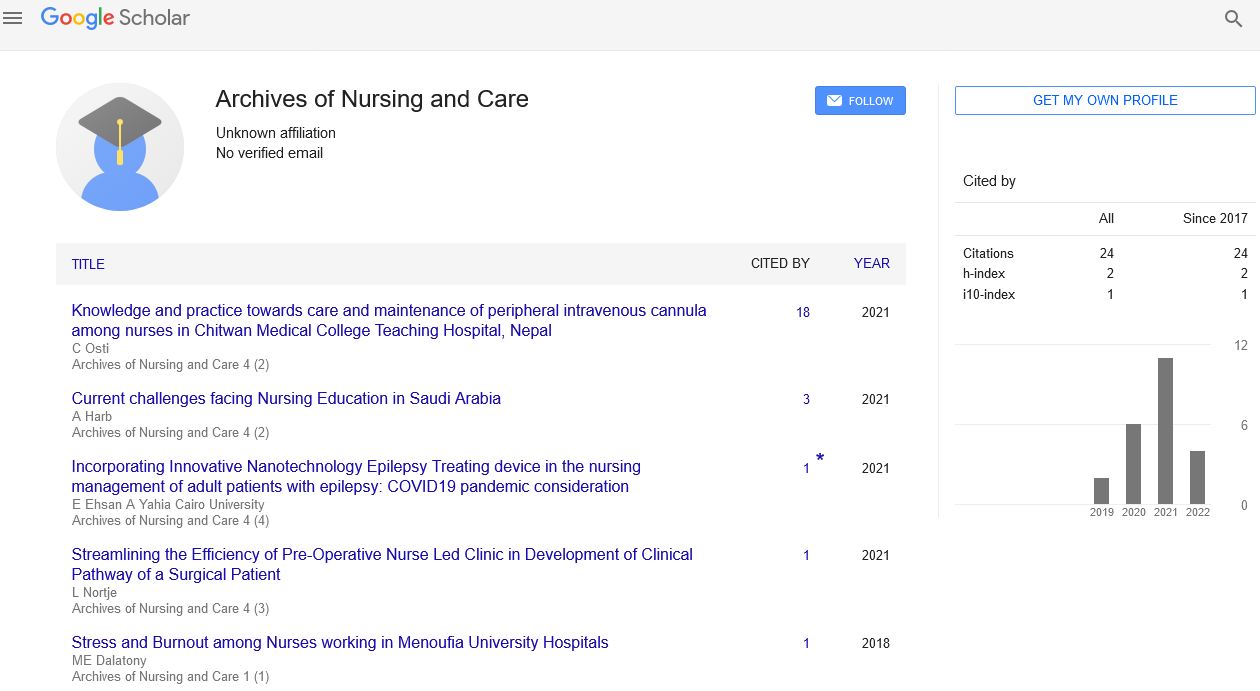Review Article - Archives of Nursing and Care (2023) Volume 6, Issue 3
Evidence-Based Guidelines for the Prevention and Treatment of Ventilator-Associated Pneumonia in Pediatric Patients.
Kenai Zou*
Department of Thoracic Surgery, Guangzhou Medical University, Guangzhou, China
Department of Thoracic Surgery, Guangzhou Medical University, Guangzhou, China
E-mail: Zoukenai@edu.mz.cn
Received: 02-June-2023, Manuscript No. OANC-23-96483; Editor assigned: 05-June-2023, PreQC No. OANC-23- 96483 (PQ); Reviewed: 19-June-2023, QC No. OANC-23-96483; Revised: 26-June-2023, Manuscript No. OANC-23- 96483 (R); Published: 30-June-2023; DOI: 10.37532/oanc.2023.6(3).56-58
Abstract
Ventilator-associated pneumonia (VAP) is the most common acquired infection in the intensive care unit. Recent studies showed that the critical COVID-19 patients with invasive mechanical ventilation have a high risk of developing VAP, which result in a worse outcome and an increasing economic burden. With the development of critical care medicine, the morbidity and mortality of VAP remains high. Especially since the outbreak of COVID-19, the healthcare system is facing unprecedented challenges. Therefore, many efforts have been made in effective prevention, early diagnosis, and early treatment of VAP. This review focuses on the treatment and prevention drugs of VAP in COVID-19 patients. In general, prevention is more important than treatment for VAP. Prevention of VAP is based on minimizing exposure to mechanical ventilation and encouraging early release. There is little difference in drug prophylaxis from non-COVID-19. In term of treatment of VAP, empirical antibiotics is the main treatment, special attention should be paid to the antimicrobial spectrum and duration of antibiotics because of the existence of drugresistant bacteria. Further studies with well-designed and large sample size were needed to demonstrate the prevention and treatment of ventilator-associated pneumonia in COVID-19 based on the specificity of COVID-19. Protocol-based approaches to critically ill patients on mechanical ventilation, closed suctioning, upper body position, enteral feeding and selective gastric acid suppression medication have a beneficial effect on VAP incidence. In recent decades, cuffed tubes applied to the whole spectrum of critically ill pediatric patients, together with cuff-oriented nursing care including proper cuff-pressure management and the use of specialized tracheal tubes with subglottic suction ports combined with close infraglottic tracheal suctioning, have been implemented.
Introduction
Ventilator-associated pneumonia (VAP) is usually regarded as a pneumonia phenomenon that occurs within 48 h after mechanical ventilation to 48 h after extubation, and is the main type of hospital-acquired pneumonia. The risk of VAP in patients with invasive mechanical ventilation is approximately 5%–40%, and has been reported to be different depending on the country, the type of intensive care unit (ICU), and the criteria of VAP identification. Not only does VAP have a significant attributable mortality rate, and VAP remains an integral part of the spectrum of adverse events such as acute respiratory distress syndrome. Although our knowledge of VAP has increased, its incidence has not decreased [1]. Since the outbreak of COVID-19, Earth shaking changes have taken place in global medical care. COVID-19 patients had a high incidence of severe ARDS, many of whom require invasive ventilation and are at a high risk of VAP, which can make the state of COVID-19 patients more complicated and more strenuous to manage. Besides, COVID-19-associated VAP shows novel characters compared to non-COVID-19 disease.
Occurrence and outcome of ventilator-associated pneumonia in COVID-19 patients VAP is thought to be the most common fatal nosocomial infections in ICU. The reported incidence of VAP varies widely in COVID-19 patients, but was different from studies. Some studies have shown a higher VAP risk in COVID-19 ARDS patients than in non-COVID-19 ARDS. It has been reported that VAP may bring poor prognosis to patients, with prolonged durations of both mechanical ventilation and ICU stay, and even a high mortality. Similarly, the association of VAP with some relevant poor outcomes was also reported in COVID-19 patients in recent studies [2]. Compared with non-COVID-19 patients, VAP in COVID-19 cases was significantly related with 28-day mortality, shock, VAP recurrence, and polymicrobial culture, as well as a significantly longer mechanical ventilation time. Meanwhile, compared with the influenza or non-virus infection group, no significant difference in the relationship between VAP with mortality was found in the COVID-19 group [3].
VAP incidence
There have been growing numbers of publications in latest years addressing the need for instituting a set of key evidencebased interventions to fight this preventable hospital-acquired infection (HAI). The importance of such preventive strategies is underlined by the lack of gold standards for VAP diagnosis [4]. Although many recent studies have demonstrated that implementing VAP prevention bundles could lead to reduced VAP incidence and the importance of such as a daily part of ICU patient care, the appropriate elements that should be included in these prevention strategies have to be evaluated further, mainly for cost–benefit purposes and to assess their efficacy.
Generally, the incidence of VAP varies, but remains unacceptably high. Differences such as patients’ profiles and nutritional status as well as resource availability and diagnostic criteria can be the source of variation. Pediatric studies across the globe report VAP incidence of 2-35%. According to the reported VAP incidence, it remains the most prevalent healthcare-associated infection in different intensive care with significant costs, morbidity and mortality worldwide [5].
Diagnosis
Despite VAP’s significance for clinical practice, there is still no gold standard for a VAP diagnostic. This could have a negative impact on the promptness of VAP management. If there is no new lung infiltrate on the imaging, the probability of a VAP diagnosis lowers and it is necessary to proceed to thinking about other alternative causes of inpatient respiratory decline [6]. However, it should be noted that in the early stages of pneumonia development, only a few signs of inflammation may be found on the X-ray, and it should be repeated over time in patients with high clinical suspicion. Additionally, standard diagnostic criteria should include at least two or three of the following: fever higher than 38°C or hypothermia lower than 36.5°C [7]; change in volume or character of sputum or increased need of suctioning; new or worsening cough; breathing problems such as dyspnea, tachypnea or apnea; pathological pulmonary auscultation with signs of rales; and bronchial breath sounds, wheezing or rhonchi. Other criteria are worsening of gas exchange after a period of either improvement on the ventilator or stability, bradycardia or tachycardia, and positive serum biomarkers such as C-reactive protein, procalcitonin or leukocytosis.
The diagnostic problem remains that all these clinical criteria have very limited value on their own. Many of the signs and symptoms mentioned above may be the consequence of other concurrent morbidities or are routinely present in patients on prolonged mechanical ventilation [8]. On the other hand, VAP clinical presentation could be significantly modified by the concurrent medication often administered to critically ill patients.
Elsewhere, the CDC-Center for Disease Control and Prevention criteria have been acceptable and used for diagnostic purposes for both pediatric and adult patients. Other criteria used may be Great Ormond Street Hospital (GOSH) criteria or Clinical Pulmonary Infection Score (CPIS). What all these different strategies for diagnosing VAP have in common is the radiographic evidence of pneumonia; what varies are clinical criteria and their respective combinations [9]. Nevertheless, there are difficulties when applying these criteria for VAP, mainly the requirement of radiographic evidence of lung infiltrate and the reliance on subjective clinical symptoms.
Taking blood cultures is recommended, as they can be helpful in either revealing the responsible pathogen if respiratory cultures are not conclusive or informing us of the presence of additional infection unrelated to the respiratory tract and therefore are important in differential diagnoses [10].
Conclusions
Ventilator-associated pneumonia is one of the most prevalent complications of ICU stay and is nowadays still associated with significant morbidity and mortality in critically ill patients. Emphasis should be put mainly on early VAP prevention, possibly by implementing certain prevention bundles, together with optimal staff compliance, quick diagnostics and early treatment.
References
- Patrick DM, Marra F, Hutchinson Jet al.Per capita antibiotic consumption: How does a North American jurisdiction compare with Europe?Clin Infect Dis. 39, 11-17 (2004).
- Li WC.Occurrence, sources, and fate of pharmaceuticals aquaticenvironmentand soil. Environ Pollute.187, 193-201 (2014).
- Heberer T.Occurrence, fate, and removal of pharmaceutical residues in the aquatic environment: A review of recent research data.Toxicol Lett.131, 5-17 (2002).
- Banci L, Ciofi-Baffoni S, Tien M Ligninet al.Peroxidase-catalyzed oxidation of phenolic lignin oligomers.Biochemistry. 38, 3205-3210 (1999).
- Deblonde T, Cossu-Leguille C, Hartemann Pet al.Emerging pollutants in wastewater: A review of the literature.Int J HygEnviron Heal. 214, 442-448 (2011).
- Tavakoli M, Emadi Z.The Relationship between Health-Promoting Lifestyle, Mental Health, Coping Styles and Religious Orientation among Isfahan University Students.J Res Behave Sci. 13, 64-78 (2015).
- Norouzinia R, Aghabarari M, Kohan Met al.Health promotion behaviors and its correlation withanxietyand some students’demographic factors of Alborz University of Medical Sciences.Journal ofHealthPromotion Management. 2, 39-49 (2013).
- Pierce C.Health promoting behaviors of rural women with heart failure.Online Journal ofNursingandHealthCare. 5, 28-37 (2005).
- Hajizadeh Sharafabad F, Alizadeh M. Predictors of health-promoting behaviors in patients withcoronary artery diseasein the Iranian population.International Journal ofNursingPractice. 11, 164-176 (2016).
- Shahbaz A, Hemmati Maslakpak M.Relationship ofself-carebehaviors with hospital readmission in people with heart failure.CardiovascularNursingJournal. 6, 24-33 (2017).
Indexed at,Google Scholar,Crossref
Indexed at,Google Scholar,Crossref
Indexed at,Google Scholar,Crossref
Indexed at,Google Scholar,Crossref
Indexed at,Google Scholar,Crossref
Indexed at,Google Scholar,Crossref
Indexed at,Google Scholar,Crossref

